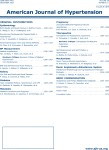Seeman T, Dostálek L, Gilík J. Am J Hypertens. 2012 Mar;25(3):389–95. doi: 10.1038/ajh.2011.218. Epub 2011 Nov 17. IF: 3.129

Department of Paediatrics
Abstract
BACKGROUND: The aim of our study was to investigate the control of hypertension (HT) in treated children using ambulatory blood pressure (BP) monitoring (ABPM). METHODS: We retrospectively reviewed all ABPM studies in our center. Controlled HT was defined as systolic and diastolic BP index (patients' BP divided by the 95th percentile) at daytime and nighttime < 1.0 or alternatively as BP load (percentage of BP readings above the 95th percentile) < 25% in children on antihypertensive therapy. RESULTS: A total of 195 ABPM studies were included. The mean age was 13.6 ± 4.0 years. One hundred and thirty two children had renoparenchymal HT, 10 renovascular (RVH), 10 endocrine, 4 cardiovascular, 29 primary (PH) and 5 children other forms of HT. 53% of all children had controlled HT. There was no difference in the prevalence of controlled HT between primary and secondary HT (52% and 53%) using the BP index criterion. Children with renoparenchymal HT had significantly better control of HT than children with RVH (58% vs. 20% P = 0.02). The use of angiotensin-converting enzyme inhibitors (ACEI) monotherapy was significantly more effective in controlling HT than the use of calcium-channel blockers (CCB, P = 0.02). The prevalence of left ventricular hypertrophy in children with uncontrolled HT (assessed in 58 patients) was significantly higher than in children with controlled HT (46% vs. 13%, P < 0.01). CONCLUSIONS: This is the first pediatric study, to our knowledge, on BP control in hypertensive children using ABPM. It indicates that control of HT is inadequate in ~50% of treated children. Inadequate control of HT is associated with target organ damage in this population.
-mk-